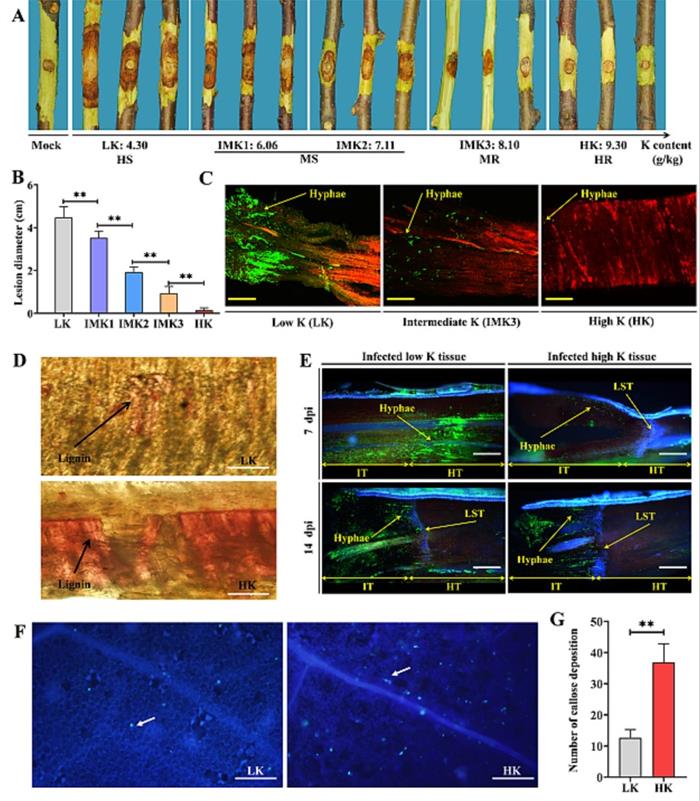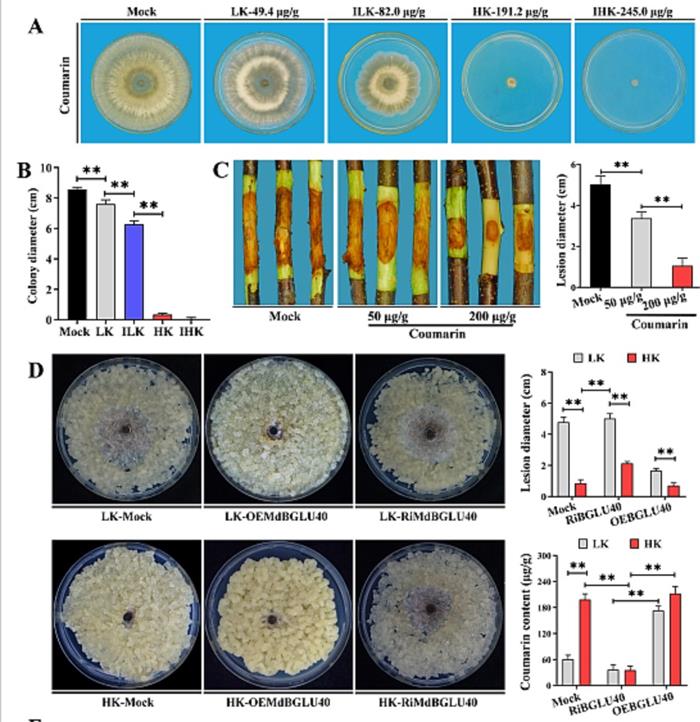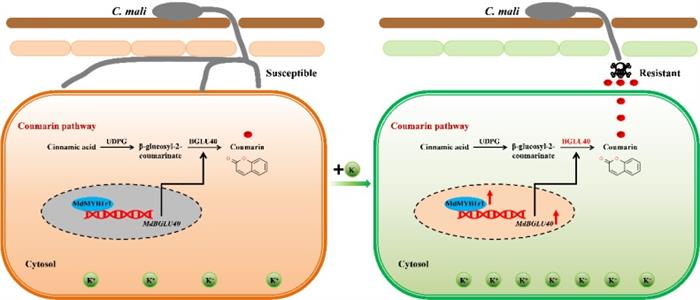On March 22nd, the fungal diversity and disease control technology team in our college published a research paper online in Plant Physiology, titled 'Sufficient coumarin accumulation improves apple resistance to Cytospora mali under high potassium status.' Doctoral student Youwei Du was the first author of the paper, and Professors Guangyu Sun and Rong Zhang were the corresponding authors.
Cytospora canker is a devastating disease of apple, causing billions of economic losses per year in China. It seriously affects the sustainable development of China's apple industry. The development of canker disease is closely related to apple tree vigor. The main cause of the outbreak of this disease in China is the potassium deficiency and nitrogen-potassium imbalance caused by excessive use of nitrogen fertilizer and insufficient use of potassium fertilizer, which leads to the weakening of tree vigor. The technique of improving tree vigor by reducing nitrogen fertilizer and increasing potassium fertilizer to prevent Cytospora canker has been widely promoted and applied in apple industry, playing an important role in controlling the occurrence and spread of the disease. However, the mechanism by which potassium promotes apple resistance to Cytospora canker is unclear.
This study found that when the potassium content of apple branches reached 0.93% (high potassium), the apple tissue showed high resistance to C. mali . Histological observations revealed that high potassium promoted the accumulation of lignin and suberin, and the formation of lignified cork layers occurred earlier and more frequently, forming a physical barrier that prevented the spread of the pathogen.

Figure 1. Increased lignin, suberin, and lignified cork layers in apple branches under sufficient potassium levels inhibit the spread of C. mali.
Transcriptome, proteome, and metabolome analyses revealed that basal resistance genes including WRKYs, RLK/RLPs, and NLRs, and pathogenesis-related (PR) proteins including PR2, PR3, and PR4 had increased expression under high potassium conditions. The accumulation of 18 antimicrobial metabolites in the phenylpropanoid pathway was increased; especially the accumulation of coumarin in high potassium tissue reached a level that completely blocked the spread of the pathogen, while its content in low potassium (0.45%) branches was only 1/4 of that in high potassium. Exogenous application of coumarin significantly inhibited the expansion of canker. The gene coding for the speed limiting enzyme of coumarin synthesis in apple, MdBGLU40, was cloned. Stable over-expression of this gene in slow potassium apple callus resulted in increased coumarin accumulation and high resistance to C. mali . Inhibiting its expression by RNAi effectively reduced the coumarin content in high potassium tissue, leading to reduced resistance. In addition, the expression level of transcription factor MdMYB1r1 was increased in high potassium apple tissue. Yeast one-hybrid, electrophoretic mobility shift assay (EMSA), and ChIP-PCR experiments showed that MdMYB1r1 could bind to the promoter of MdBGLU40, activate coumarin synthesis in apple. And the affinity of MdMYB1r1 with the promoter of MdBGLU40 was significantly enhanced by high potassium. This indicates that MdMYB1r1 is potassium-regulated and is an important transcription factor that affects coumarin synthesis. This study reveals the physical, chemical, and molecular mechanisms by which high potassium enhances apple resistance, providing a theoretical basis for the rational use of potassium nutrition to control the occurrence of apple canker disease.

Figure 2. Accumulation of sufficient coumarin is a key for potassium nutrition enhanced apple resistance to Cytospora canker.

Figure 3. Schematic diagram of potassium nutrition promoting immune response in apple
Team members including Xiaofei Liang, Mingqi Zhu, doctoral students Hongchen Jia, Sadia Noorin, and master students Zi Yang, Shuanghong Wang, and Yuanyuan Liu participated in the project. Professors Mark L. Gleason from Iowa State University and Tom Hsiang from the University of Guelph in Canada also participated in the study. The project was supported by the National Key R&D Program of China (2019YFD1002000), the National Modern Apple Industry Technology System Project (CARS27), and the Key Industry Innovation Chain Project of Shaanxi Province Science and Technology Coordination and Innovation Engineering Plan (2016KTZDNY03-04-02).
Original article: https://academic.oup.com/plphys/advance-article/doi/10.1093/plphys/kiad184/7081641